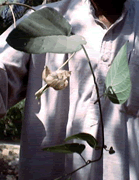
Trivrut (Species 1)

Common Names
About  Taxonomy
Taxonomy
 to access the GRIN database record about the specific taxonomical hierarchy (Family, Genus etc.).
to access the GRIN database record about the specific taxonomical hierarchy (Family, Genus etc.).CLASSIFICATION
ALTERNATE FAMILY
SUBTRIBE
SPECIES
Plant Description
Herbs perennial. Roots fleshy, long, much branched. Stems reddish, to 4 m, narrowly 3-5-winged, ± angular, gla-brous or densely pilose-tomentose on young parts. Petiole 2-10 cm, often winged; leaf blade cordate-circular, ovate, broadly ovate, ovate-lanceolate, or lanceolate, 4-14 X 3.5-14 cm, abaxially pubescent, adaxially appressed pilose to gla-brous, base cordate, truncate or obtuse, margin entire or undulate, apex acute or acuminate, mucronulate. Inflorescences cymose, often 2-flowered; peduncles 0.5-3 cm, usually terete; bracts 2, oblong to ovate-oblong, 1-2.5 cm, concave, pubescent. Pedicel 1.5-2 cm, striate-angular, clavate, to 4 cm in fruit. Sepals ovate to broadly ovate, unequal; outer 2 sepals 1.5-2 cm, abaxially pubescent; inner 3 shorter, subglabrous. Corolla white, sometimes with a yellowish base inside, broadly funnelform, 3.5-4 cm, glabrous, minutely yellowish glandular outside; limb 5-lobed. Filaments pubescent basally; anthers twisted. Fruit enclosed in cupular calyx, depressed globose, ca. 1.5 cm in diam. Seeds dull black, ovoid-trigonous, ca. 6 mm, glabrous. 2n = 30..
NLAM BLOG DATA
- Ayurveda references inform about two varities of Trivrut; Shwet (white variety) and Krishna (black variety or dark coloured variety).
- O. turpethum is accepted as the source of Shwet Trivrut. However Krishna- Trivrut is a disputed plant as per its botanical identity
- Many scholars accept the root of the plant Marsdenia tennicassima as the source of black variety of Trivrut. M. tennicassima is accepted as the source of another classical plant Moorva



 Your current navigation map.
Your current navigation map.